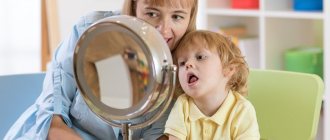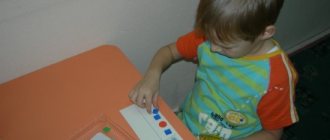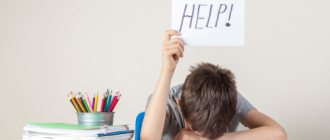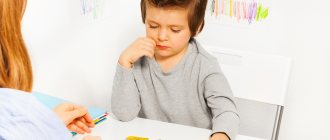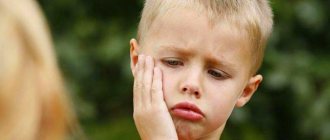Methods of neuropsychological correction of developmental disorders in children
Educational psychology | World of Pedagogy and Psychology No. 3 (32) March 2019
UDC 37.015.3
Publication date 03/31/2019
Koryabina Galina Vladimirovna - Shevyreva Elena Gennadievna Associate Professor, Can. psycho. n.
Abstract: Abstract. The article reveals some methods and techniques for correcting developmental disorders in children, used in the field of neuropsychology, which have proven most effective in working with modern children who have various forms of dysontogenesis. In the educational sphere, the following may be applicable: the method of replacement dysontogenesis Semenovich A.V., Brain gymnastics by P. Dennison, Sensory integration by J. Iris, assessment of neuromotor readiness for learning by P. Blythe. Common to all considered neuropsychological methods is the principle of influence: improving the functioning of higher mental functions through influencing the human body through special, specific, but simple motor exercises and actions. Key words: neuropsychology, Replacement Ontogenesis Method, Brain gymnastics, sensory integration
Neuropsychological methods of correction of violations of children's development
Koryabina Galina Vladimirovna Municipal budgetary preschool educational institution "Kindergarten No. 8", Rostov-on-Don Shevyreva Elena Gennadievna Southern Federal University, Academy of Psychology and Pedagogy, Associate Professor of the Department of Educational Psychology, Rostov-on-Don
Abstract: The article reveals some methods and techniques of correction of developmental disorders of children used in the field of neuropsychology, which proved the most effective in working with modern children with different forms of dysontogenesis. In the educational sphere can be applied: the method of substitutive dysontogenesis Semenovich AV, P. Dennison's brain Gymnastics, Sensory integration J. Iris, neuromotion assessment of readiness for training - P. Bligh. Common to all considered neuropsychological methods is the principle of influence: improving the work of higher mental functions through the impact on the human body through special, specific, but simple motor exercises and actions. Keywords: neuropsychology, the Method of replacement of ontogenesis, Gymnastics of the brain, sensory integration
Modern society is faced with the phenomenon of a widespread decline in the norms of mental development of children and an abundance of dysfunctions in the child’s body. In this regard, both domestic and foreign psychologists are actively searching, developing and implementing methods for the correction and rehabilitation of dysontogenetic problems in the child population. Child neuropsychology takes a priority place in solving problems of unformed voluntary regulation, disorders of the emotional-volitional and cognitive spheres, personal immaturity, and a slow pace of mental development. This science studies the formation of the brain organization of mental functions. Neuropsychological correction of children is work with various forms of dysontogenesis. An important condition for the positive effect of correctional work is its timeliness. Difficulties in development, learning and behavior can be overcome with the help of neuropsychological methods in the age period from 3 to 13 years. This result may be possible due to the high plasticity of the human brain.
Currently, there are many different methods in neuropsychology, I would like to dwell in more detail on some of them.
One of the most effective and thoroughly developed is the neuropsychological approach, based on the model of A.R. Luria talks about three structural and functional blocks, each of which has its own specific function in the mental structure of the brain. The first block is energy, responsible for regulating the necessary tone of the nervous system and maintaining an optimal level of wakefulness (nonspecific activation). The second block is the block for receiving, storing and processing information (it includes the main analytical systems that enable a person to see, hear, and feel the information received). And the third block is the block of programming, regulation and control over the course of complex forms of mental activity of the body. The essence of the method of replacement ontogenesis (MSO) (B.A. Arkhipov, A.V. Semenovich, S.O. Umrikhin, A.A. Tsyganok, etc.) is based on the theory of A.R. Luria about three functional blocks of the brain. A significant advantage over other methods is the versatility of using MZO; it has a large correction coefficient for a different range of child development disorders. Its goal is the development of all higher mental functions by influencing the sensorimotor level.
The principle of operation of MZO is based on establishing a connection between the level of actual development of the child and the stages of formation of the brain organization of mental processes. The work consists of reproducing those areas of ontogenesis that, for one reason or another, have not been effectively developed. The specialist must identify problematic stages of development and include special exercises in the work that will replace areas not addressed by the system. The correction focuses on three areas: 1) “Warm-up and outdoor games for attention”, 2) “Psychomotor coordination”, 3) “Cognitive abilities”. The program is quite extensive and includes 18 weeks of classes, this is where the difficulty of correctional work lies. In this case, the condition for a successful result will be a clear sequence in performing the exercises.
Another neuropsychological method that has already earned recognition among specialists working with children is “Brain Gymnastics”. The goal of the method is to improve and develop the characteristics of mental processes (memory, attention, thinking), emotional-volitional sphere by restoring impaired interhemispheric connections of the brain with the help of easy-to-perform movement exercises. The Brain Gym set of exercises was developed by Paul and Gail Dennison. The essence of the method is based on the idea that sensorimotor development is directly related to mental development. By performing simple movements, we stimulate or trigger effective brain function, solving intellectual problems, building emotional balance, and relieving stress. The effectiveness of using exercises can be observed in a fairly quick period of time. That is why they are so convenient to use as morning exercises not only for children, but for adults, or before an important event or performance. Performing motor exercises in a regular, long-term format will allow the nervous system to be maximally balanced and work productively as a healthy body, and will provide the opportunity to level out pathological manifestations of mental activity. The exercises are divided into four groups. 1. Movements crossing the midline of the body. These exercises integrate the hemispheres of the brain, develop binocular vision, binacular hearing and coordination of the two hands. 2. Energizing exercises (promote the transmission of neural signals between the brain and the rest of the body). Performing such special movements will help improve your emotional state, improve relationships with others, organize yourself and act decisively in difficult situations. 3. Stretching exercises. They aim to relax major muscle groups and tendons and are therefore effective in reducing stress. 4. Exercises that increase a positive attitude - help to establish coordination of actions and thoughts [3].
Methodology for assessing and correcting neuromotor readiness for learning at school, aimed at identifying and correcting signs of neuromotor immaturity in children, which are the cause of numerous learning difficulties. It was developed by the English psychologist Peter Blythe and has proven its effectiveness as a result of many years of use in educational organizations in Europe and the USA, confirmed by research by the author and his assistants. The scientific basis of the technique is to affirm the close connection between neuromotor immaturity and school difficulties (cognitive difficulties, problems in mastering reading, writing, processing mathematical information, maintaining attention during a lesson, etc.). The nervous system will work smoothly provided that primary reflexes are integrated in a timely manner (early age). If, for various psychophysiological or external reasons, this does not happen, and the reflexes remain in an active state, then certain movements are not processed in due time (for example, crawling) and thinking processes in the cortical areas of the brain are blocked. This leads to various kinds of developmental problems, including school difficulties. The program for the correction of neuromotor pathologies is available for use not only by specialists (psychologists, speech pathologists, teachers), but also by parents and consists, in fact, of simple motor exercises that train and complete the nervous system through certain movements that were in short supply at a certain age period child.
The sensory integration method was developed by American occupational therapist Jean Ayres, who worked on solving neurological problems in children and adults. Its goal is to strengthen, balance, and develop the processing of sensory stimuli in the child’s nervous system. The method is aimed at stimulating the auditory, visual, kinesthetic, vestibular systems through the coordination of the senses using special equipment and games that affect the analyzers. Sensory integration disorders occur when the mechanism of unified perception and processing of sensory signals does not work or works distorted. Sensory integration disorders in children manifest themselves in a variety of ways: refusal to wear clothes that are uncomfortable for the child, reluctance to touch surfaces of different textures and substances (sand, paint, plasticine), fear of swings and merry-go-rounds, apraxia (problems with household objects), dyslexia (difficulty with writing) , counting), ADHD, impaired sense of boundaries of the body and space. Dysfunction consists of increased or decreased sensitivity of the analyzing systems. Children's sensory development is closely related to sensory integration. To develop sensory integration, it is possible to use games aimed at training each of the systems: visual (games for visual perception, hiding and searching for objects), auditory (games for correlating objects, objects or sounds belonging to them), tactile (all kinds of work with tactile material, massage and self-massage), gustatory (working with food), olfactory (games to develop sensitivity to smells), vestibular (special outdoor games with a ball, jump rope, rope, ladder, balancing board.).
When working with children who have various developmental difficulties, the need to use neuropsychological methods becomes clear, and their use in combination significantly increases the chances of obtaining positive results.
Bibliography
1. Ayres, E. J. The child and sensory integration. Understanding hidden developmental problems / E. J. Ayres; [transl. from English Yulia Dara]. Moscow, 2009 - 272 p. 2. Bolotskaya I.M. Neuropsychological methods in the work of a teacher-psychologist in the context of the implementation of the Federal State Educational Standard for Education. // ASOU Conference. Collection of scientific papers and materials of scientific and practical conferences - 2016 3. Dennison Paul E., Dennison Gail E. Brain gymnastics. A book for teachers and parents. Publishing house: Ves, 2022 – 320 p. 4. Godard Blythe S. Assessment of neuromotor readiness for learning, Moscow, 2022, 213 p. 5. Semenovich A.V. Neuropsychological correction in childhood. Method of replacement ontogenesis: Textbook. - M.: Genesis, 2007. - 474 p. 6. Simernitskaya E.G. Brain and mental processes in ontogenesis. M.: Moscow State University Publishing House, 1985. 7. Fedorenko E.I. Health-saving technologies. Neuropsychological approach to working with preschool children.//Continuity in education -2018. 8. Khomskaya E.D. Neuropsychology.4th ed. – St. Petersburg: Peter, 2011.- 496 p.
← Previous articleThe role of interactive teaching methods in the development of linguistic abilities
Next article →Peculiarities of writing in primary schoolchildren with intellectual disabilities
Tell your friends about us:
Method components
Neuropsychological diagnostics and behavior correction in childhood are conventionally divided into two inextricably linked components:
- Motor correction;
- Cognitive or educational correction.
The first component, already described above, serves to stimulate the regulation of movements, improve interhemispheric interaction and the development of children’s spatial representations.
The second component, cognitive correction, is aimed at developing cognitive skills and overcoming the child’s learning difficulties.
To create stable and positive motivation in a child, neurocorrection classes are conducted in a playful way.
The course of motor correction includes at least 25 lessons. One lesson lasts from 40 to 60 minutes, depending on age. Make an appointment Addresses and telephone numbers of branches in Moscow Ask a question Reviews
